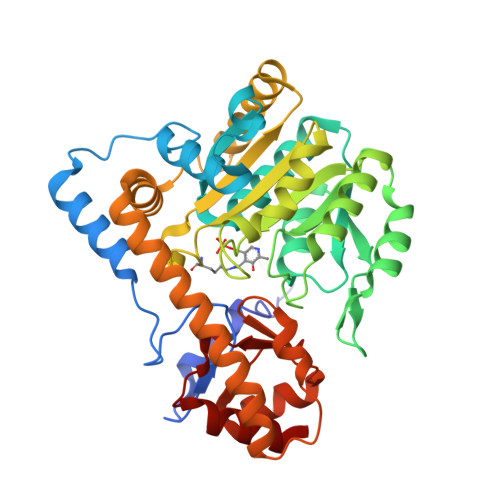Narrowing substrate specificity in a directly evolved enzyme: the A293D mutant of aspartate aminotransferase
Chow, M.A., McElroy, K.E., Corbett, K.D., Berger, J.M., Kirsch, J.F.(2004) Biochemistry 43: 12780-12787
- PubMed: 15461450
- DOI: https://doi.org/10.1021/bi0487544
- Primary Citation of Related Structures:
1TOE, 1TOG, 1TOI, 1TOJ, 1TOK - PubMed Abstract:
Several mutant Escherichia coli aspartate aminotransferases (eAATases) have been characterized in the attempt to evolve or rationally redesign the substrate specificity of eAATase into that of E. coli tyrosine aminotransferase (eTATase). These include HEX (designed), HEX + A293D (design followed by directed evolution), and SRHEPT (directed evolution). The A293D mutation realized from directed evolution of HEX is here imported into the SRHEPT platform by site-directed mutagenesis, resulting in an enzyme (SRHEPT + A293D) with nearly the same ratio of k(cat)/K(m)(Phe) to k(cat)/K(m)(Asp) as that of wild-type eTATase. The A293D substitution is an important specificity determinant; it selectively disfavors interactions with dicarboxylic substrates and inhibitors compared to aromatic ones. Context dependence analysis is generalized to provide quantitative comparisons of a common substitution in two or more different protein scaffolds. High-resolution crystal structures of ligand complexes of HEX + A293D, SRHEPT, and SRHEPT + A293D were determined. We find that in both SRHEPT + A293D and HEX + A293D, the additional mutation holds the Arg 292 side chain away from the active site to allow increased specificity for phenylalanine over aspartate. The resulting movement of Arg 292 allows greater flexibility of the small domain in HEX + A293D. While HEX is always in the closed conformation, HEX + A293D is observed in both the closed and a novel open conformation, allowing for more rapid product release.
Organizational Affiliation:
Department of Molecular and Cell Biology, University of California, Berkeley, California 94720-3206, USA.
















